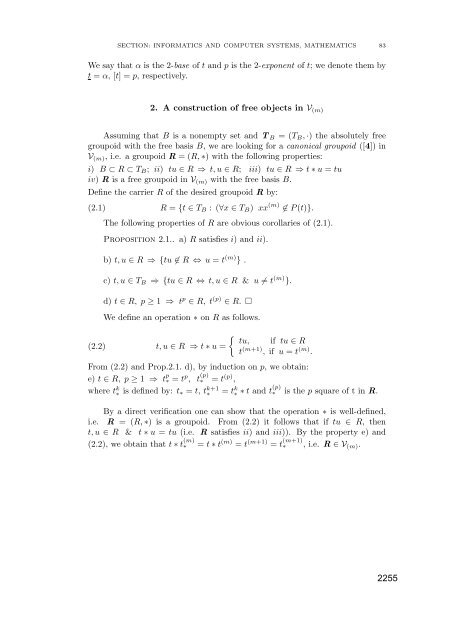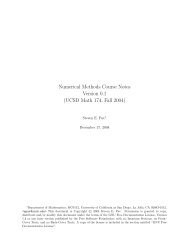FREE OBJECTS IN THE VARIETY OF GROUPOIDS DEFINED BY ...
FREE OBJECTS IN THE VARIETY OF GROUPOIDS DEFINED BY ...
FREE OBJECTS IN THE VARIETY OF GROUPOIDS DEFINED BY ...
You also want an ePaper? Increase the reach of your titles
YUMPU automatically turns print PDFs into web optimized ePapers that Google loves.
SECTION: <strong>IN</strong>FORMATICS AND COMPUTER SYSTEMS, MA<strong>THE</strong>MATICS 83<br />
We say that α is the 2-base of t and p is the 2-exponent of t; we denote them by<br />
t = α, [t] =p, respectively.<br />
2. A construction of free objects in V (m)<br />
Assuming that B is a nonempty set and T B =(T B , ·) the absolutely free<br />
groupoid with the free basis B, we are looking for a canonical groupoid ([4]) in<br />
V (m) , i.e. a groupoid R =(R, ∗) with the following properties:<br />
i) B ⊂ R ⊂ T B ; ii) tu ∈ R ⇒ t, u ∈ R; iii) tu ∈ R ⇒ t ∗ u = tu<br />
iv) R is a free groupoid in V (m) with the free basis B.<br />
Define the carrier R of the desired groupoid R by:<br />
(2.1) R = {t ∈ T B :(∀x ∈ T B ) xx (m) ∉ P (t)}.<br />
The following properties of R are obvious corollaries of (2.1).<br />
Proposition 2.1.. a) R satisfies i) and ii).<br />
b) t, u ∈ R ⇒{tu ∉ R ⇔ u = t (m) } .<br />
c) t, u ∈ T B ⇒{tu ∈ R ⇔ t, u ∈ R & u ≠ t (m) }.<br />
d) t ∈ R, p ≥ 1 ⇒ t p ∈ R, t (p) ∈ R. □<br />
We define an operation ∗ on R as follows.<br />
(2.2) t, u ∈ R ⇒ t ∗ u =<br />
{ tu, if tu ∈ R<br />
t (m+1) , if u = t (m) .<br />
From (2.2) and Prop.2.1. d), by induction on p, we obtain:<br />
e) t ∈ R, p ≥ 1 ⇒ t p ∗ = t p , t (p)<br />
∗ = t (p) ,<br />
where t k ∗ is defined by: t ∗ = t, t k+1<br />
∗ = t k ∗ ∗ t and t (p)<br />
∗ is the p square of t in R.<br />
By a direct verification one can show that the operation ∗ is well-defined,<br />
i.e. R = (R, ∗) is a groupoid. From (2.2) it follows that if tu ∈ R, then<br />
t, u ∈ R & t ∗ u = tu (i.e. R satisfies ii) and iii)). By the property e) and<br />
(2.2), we obtain that t ∗ t (m)<br />
∗<br />
= t ∗ t (m) = t (m+1) = t (m+1)<br />
∗ , i.e. R ∈V (m) .<br />
2255














